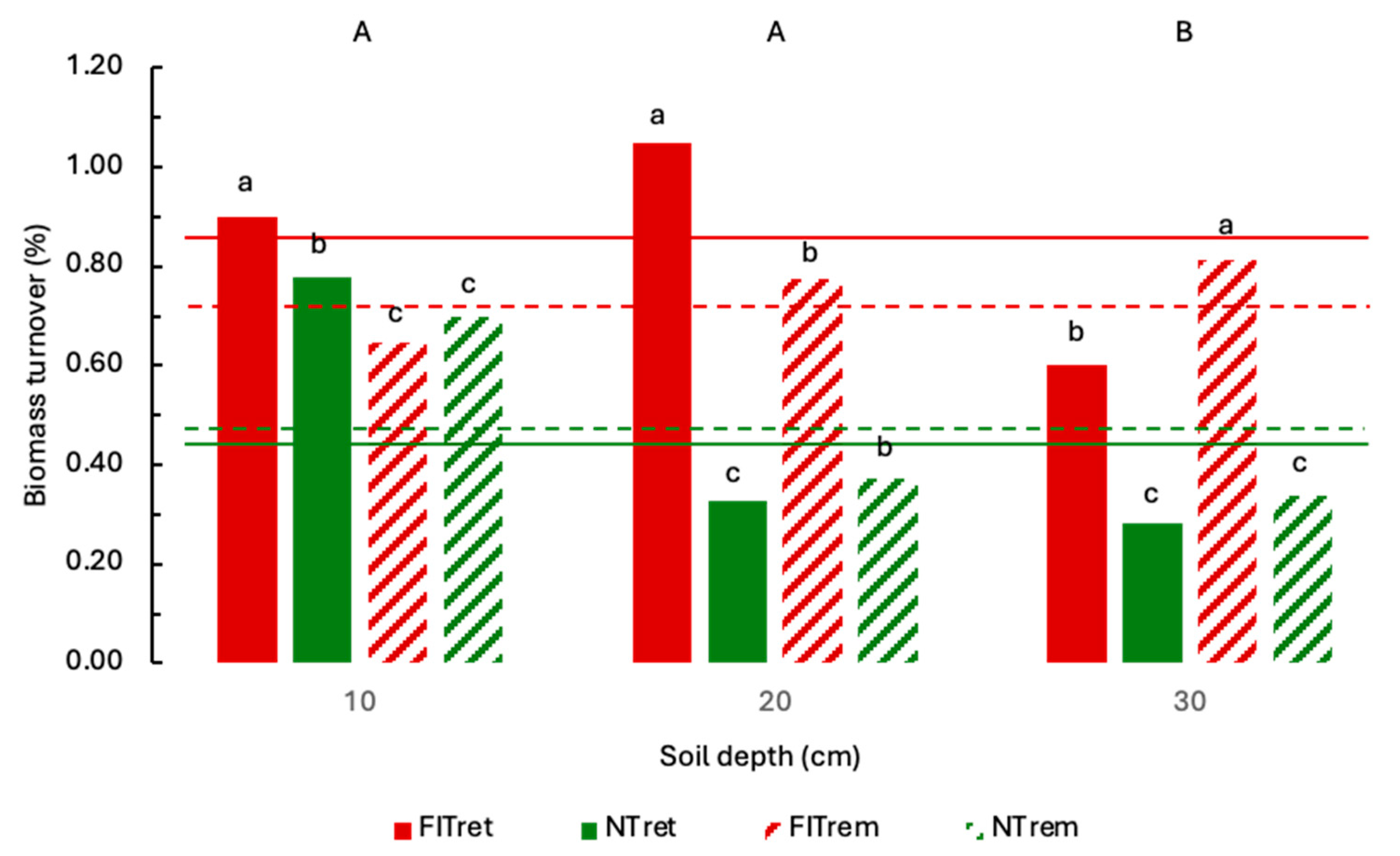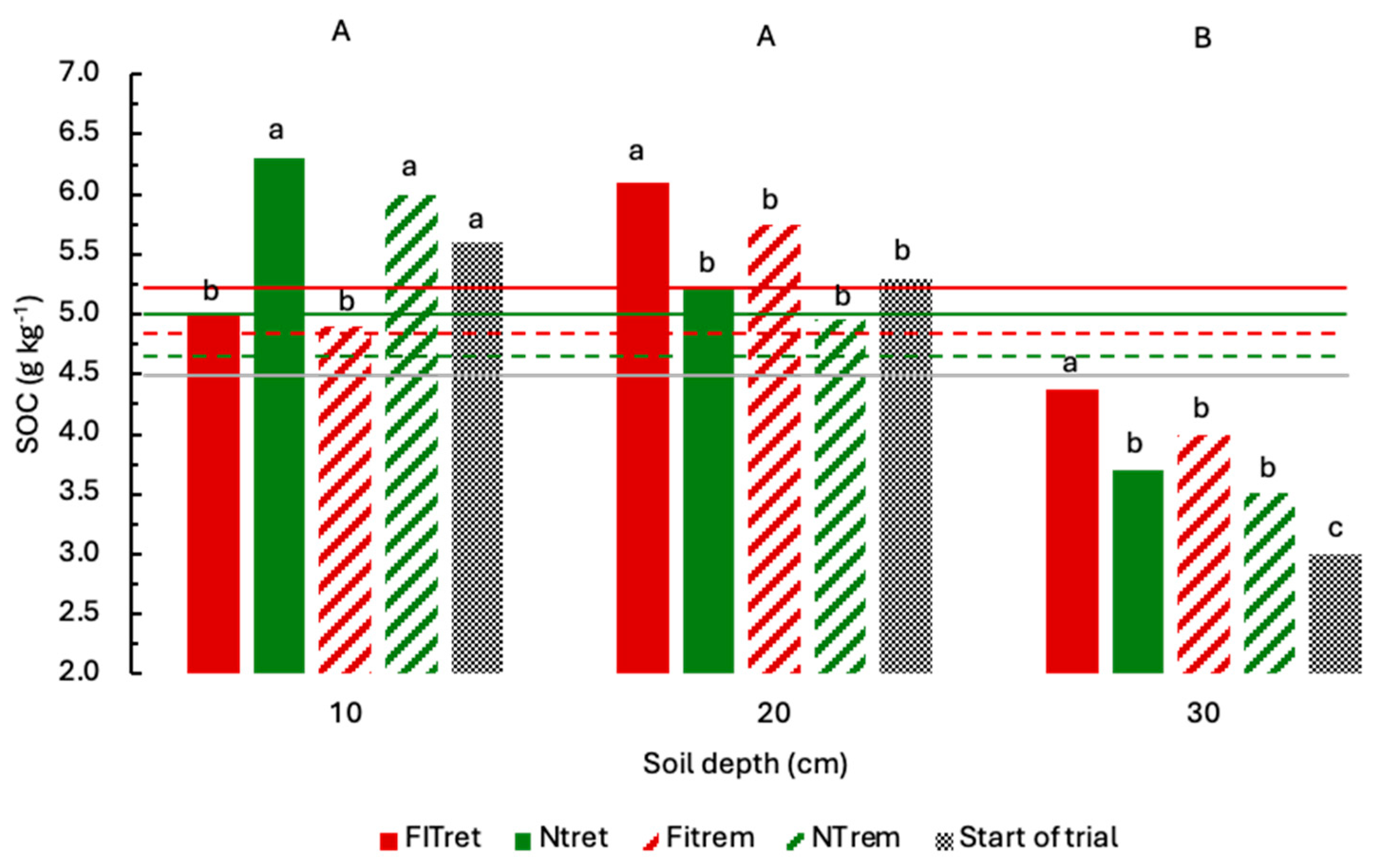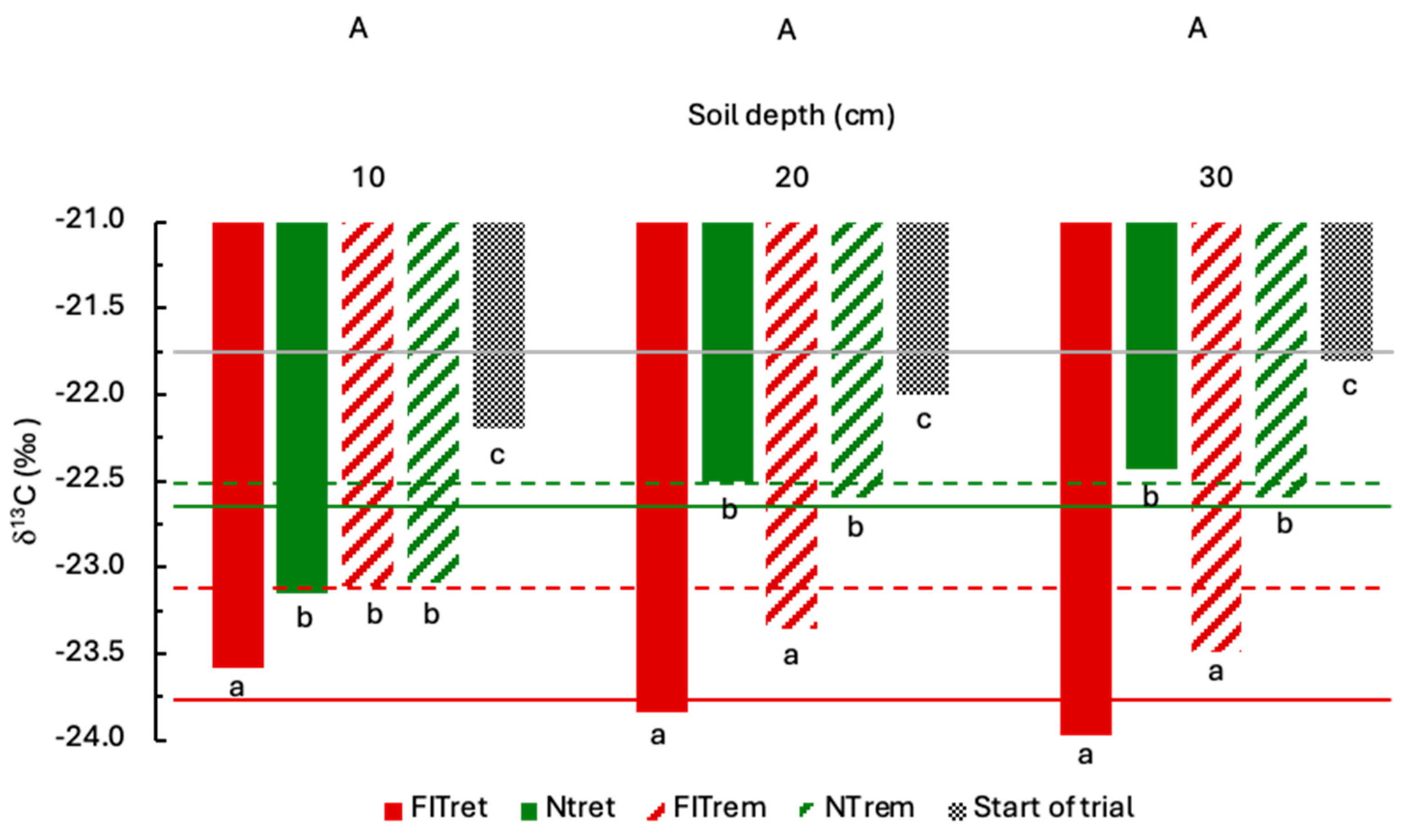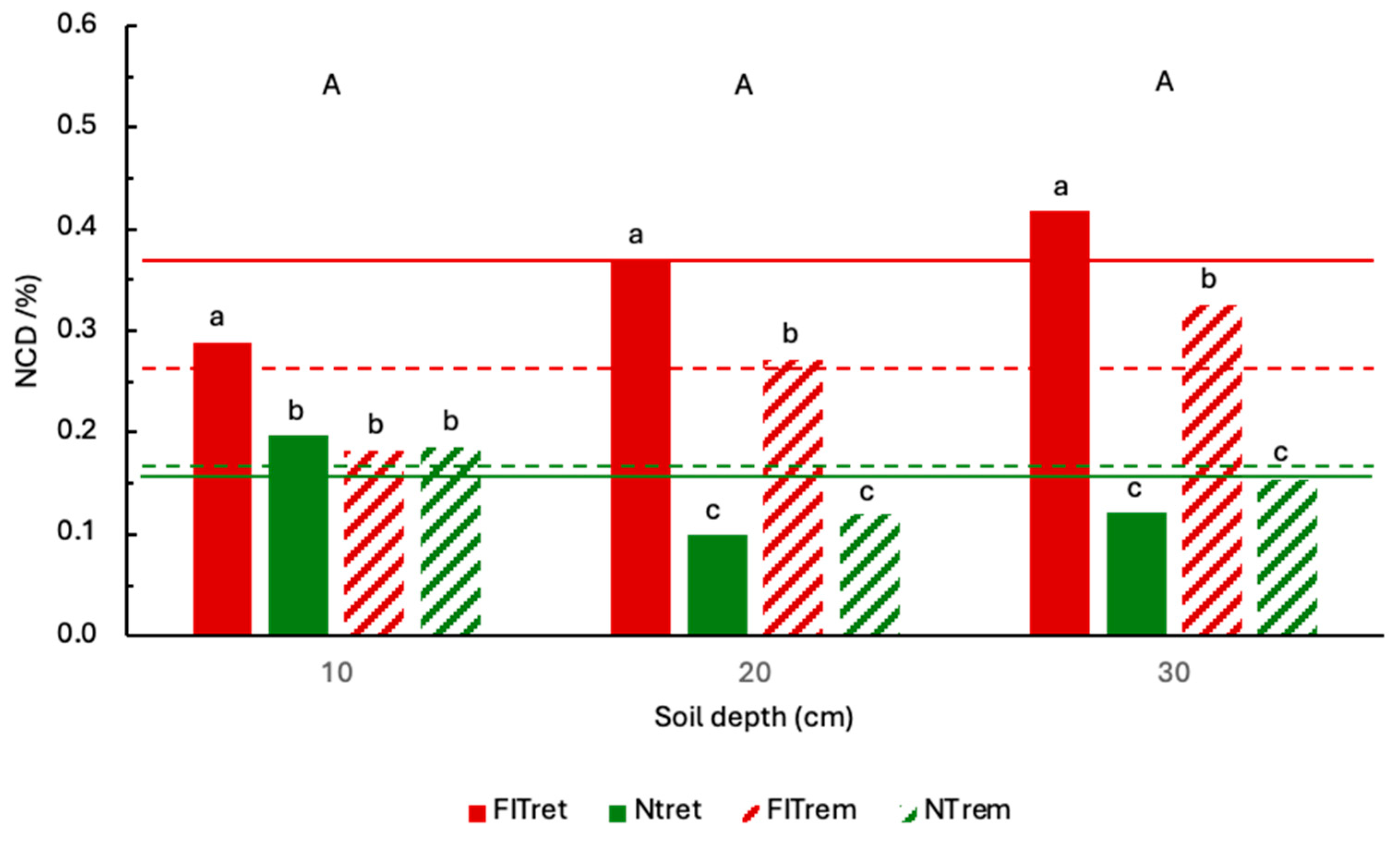Carbon Input and Crop Residue Placement Determine the Carbon Sequestration Efficiency of Soil Management Techniques
Abstract
1. Introduction
2. Materials and Methods
2.1. Site Description
2.2. Experimental Set-Up
2.3. Soil Sampling and Analysis
2.4. Carbon Input
2.5. Soil Respiration
2.6. Statistical Analysis
3. Results and Discussion
3.1. Residue Biomass Input into the Soil
3.2. Biomass Turnover
3.3. Soil Organic Carbon (SOC) Placement
3.4. Carbon Isotopic Signature (δ13C)
3.5. New Carbon Derived (NCD)
3.6. Carbon Incorporation Efficiency
3.7. The Impact of Biomass Input on Soil Organic Carbon Mineralization
3.8. SOC Turnover
4. Conclusions
Author Contributions
Funding
Data Availability Statement
Conflicts of Interest
References
- World Resources Institute. Creating a Sustainable Food Future: Final Report; Searchinger, T., Waite, R., Beringer, T., Eds.; WRI: Washington, DC, USA, 2019; ISBN 978-1-56973-963-1. [Google Scholar]
- Moinet, G.Y.K.; Hijbeek, R.; van Vuuren, D.P.; Giller, K.E. Carbon for Soils, Not Soils for Carbon. Glob. Change Biol. 2023, 29, 2384–2398. [Google Scholar] [CrossRef] [PubMed]
- Bossio, D.A.; Cook-Patton, S.C.; Ellis, P.W.; Fargione, J.; Sanderman, J.; Smith, P.; Wood, S.; Zomer, R.J.; von Unger, M.; Emmer, I.M.; et al. The Role of Soil Carbon in Natural Climate Solutions. Nat. Sustain. 2020, 3, 391–398. [Google Scholar] [CrossRef]
- Francaviglia, R.; Di Bene, C.; Farina, R.; Salvati, L.; Vicente-Vicente, J.L. Assessing “4 per 1000” soil organic carbon storage rates under Mediterranean climate: A comprehensive data analysis. Mitig. Adapt. Strateg. Glob. Change 2019, 24, 795–818. [Google Scholar] [CrossRef]
- Poulton, P.; Johnston, J.; Macdonald, A.; White, R.; Powlson, D. Major Limitations to Achieving “4 per 1000” Increases in Soil Organic Carbon Stock in Temperate Regions: Evidence from Long-Term Experiments at Rothamsted Research, United Kingdom. Glob. Change Biol. 2018, 24, 2563–2584. [Google Scholar] [CrossRef] [PubMed]
- Chenu, C.; Angers, D.A.; Barré, P.; Derrien, D.; Arrouays, D.; Balesdent, J. Increasing Organic Stocks in Agricultural Soils: Knowledge Gaps and Potential Innovations. Soil Tillage Res. 2019, 188, 41–52. [Google Scholar] [CrossRef]
- Bruni, E.; Lugato, E.; Chenu, C.; Guenet, B. European Croplands under Climate Change: Carbon Input Changes Required to Increase Projected Soil Organic Carbon Stocks. Sci. Total Environ. 2024, 954, 176525. [Google Scholar] [CrossRef]
- Liang, B.C.; VandenBygaart, A.J.; MacDonald, J.D.; Cerkowniak, D.; McConkey, B.G.; Desjardins, R.L.; Angers, D.A. Revisiting No-till’s Impact on Soil Organic Carbon Storage in Canada. Soil Tillage Res. 2020, 198, 104529. [Google Scholar] [CrossRef]
- Novara, A.; Minacapilli, M.; Santoro, A.; Rodrigo-Comino, J.; Carrubba, A.; Sarno, M.; Venezia, G.; Gristina, L. Real cover crops contribution to soil organic carbon sequestration in sloping vineyard. Sci. Total Environ. 2019, 652, 300–306. [Google Scholar] [CrossRef]
- Meurer, K.H.E.; Haddaway, N.R.; Bolinder, M.A.; Kätterer, T. Tillage Intensity Affects Total SOC Stocks in Boreo-Temperate Regions Only in the Topsoil—A Systematic Review Using an ESM Approach. Earth Sci. Rev. 2018, 177, 613–622. [Google Scholar] [CrossRef]
- Ding, W.; Zvomuya, F.; Cao, M.; Wu, Y.; Liu, Z.; He, H. Ground Cover Management Improves Orchard Soil Moisture Content: A Global Meta-Analysis. J. Hydrol. 2024, 633, 130710. [Google Scholar] [CrossRef]
- Mazzoncini, M.; Antichi, D.; Di Bene, C.; Risaliti, R.; Petri, M.; Bonari, E. Soil Carbon and Nitrogen Changes after 28 Years of No-Tillage Management under Mediterranean Conditions. Eur. J. Agron. 2016, 77, 156–165. [Google Scholar] [CrossRef]
- Francaviglia, R.; Di Bene, C.; Farina, R.; Salvati, L. Soil Organic Carbon Sequestration and Tillage Systems in the Mediterranean Basin: A Data Mining Approach. Nutr. Cycl. Agroecosyst. 2017, 107, 125–137. [Google Scholar] [CrossRef]
- Badagliacca, G.; Benítez, E.; Amato, G.; Badalucco, L.; Giambalvo, D.; Laudicina, V.A.; Ruisi, P. Long-Term Effects of Contrasting Tillage on Soil Organic Carbon, Nitrous Oxide and Ammonia Emissions in a Mediterranean Vertisol under Different Crop Sequences. Sci. Total Environ. 2018, 619–620, 18–27. [Google Scholar] [CrossRef] [PubMed]
- López-Bellido, L.; López-Bellido, R.; Fernández-García, P.; Muñoz-Romero, V.; Lopez-Bellido, F.J. Carbon Storage in a Rainfed Mediterranean Vertisol: Effects of Tillage and Crop Rotation in a Long-Term Experiment. Eur. J. Soil Sci. 2020, 71, 472–483. [Google Scholar] [CrossRef]
- Valkama, E.; Kunypiyaeva, G.; Zhapayev, R.; Karabayev, M.; Zhusupbekov, E.; Perego, A.; Schillaci, C.; Sacco, D.; Moretti, B.; Grignani, C.; et al. Can Conservation Agriculture Increase Soil Carbon Sequestration? A Modelling Approach. Geoderma 2020, 369, 114298. [Google Scholar] [CrossRef]
- Aguilera, E.; Lassaletta, L.; Gattinger, A.; Gimeno, B.S. Agriculture, Ecosystems and Environment Managing Soil Carbon for Climate Change Mitigation and Adaptation in Mediterranean Cropping Systems: A Meta-Analysis. Agric. Ecosyst. Environ. 2013, 168, 25–36. [Google Scholar] [CrossRef]
- Fuentes-Ponce, M.; Gutiérrez-Díaz, J.; Flores-Macías, A.; González-Ortega, E.; Ponce-Mendoza, A.; Rodríguez-Sánchez, L.M.; Novotny, I.; Moreno-Espíndola, I.P. Direct and indirect greenhouse gas emissions under conventional, organic, and conservation agriculture. Agric. Ecosyst. Environ. 2022, 340, 108148. [Google Scholar] [CrossRef]
- Novara, A.; Sarno, M.; Gristina, L. No till Soil Organic Carbon Sequestration Could Be Overestimated When Slope Effect Is Not Considered. Sci. Total Environ. 2021, 757, 143758. [Google Scholar] [CrossRef]
- Haddaway, N.R.; Hedlund, K.; Jackson, L.E.; Kätterer, T.; Lugato, E.; Thomsen, I.K.; Jørgensen, H.B.; Isberg, P.E. How Does Tillage Intensity Affect Soil Organic Carbon? A Systematic Review. Environ. Evid. 2017, 6, 30. [Google Scholar] [CrossRef]
- Xiao, L.; Zhou, S.; Zhao, R.; Greenwood, P.; Kuhn, N.J. Evaluating Soil Organic Carbon Stock Changes Induced by No-Tillage Based on Fixed Depth and Equivalent Soil Mass Approaches. Agric. Ecosyst. Environ. 2020, 300, 106982. [Google Scholar] [CrossRef]
- Wang, H.; Wang, S.; Yu, Q.; Zhang, Y.; Wang, R.; Li, J.; Wang, X. No Tillage Increases Soil Organic Carbon Storage and Decreases Carbon Dioxide Emission in the Crop Residue-Returned Farming System. J. Environ. Manag. 2020, 261, 110261. [Google Scholar] [CrossRef] [PubMed]
- Gristina, L.; Keesstra, S.; Novara, A. No-till Durum Wheat Yield Success Probability in Semi Arid Climate: A Methodological Framework. Soil Tillage Res. 2018, 181, 29–36. [Google Scholar] [CrossRef]
- Almagro, M.; Garcia-Franco, N.; Martínez-Mena, M. The Potential of Reducing Tillage Frequency and Incorporating Plant Residues as a Strategy for Climate Change Mitigation in Semiarid Mediterranean Agroecosystems. Agric. Ecosyst. Environ. 2017, 246, 210–220. [Google Scholar] [CrossRef]
- Basile-Doelsch, I.; Balesdent, J.; Pellerin, S. Reviews and Syntheses: The Mechanisms Underlying Carbon Storage in Soil. Biogeosci. Discuss. 2020, 17, 5223–5242. [Google Scholar] [CrossRef]
- Novara, A.; Poma, I.; Sarno, M.; Venezia, G.; Gristina, L. Long-Term Durum Wheat-Based Cropping Systems Result in the Rapid Saturation of Soil Carbon in the Mediterranean Semi-Arid Environment. Land. Degrad. Dev. 2016, 27, 612–619. [Google Scholar] [CrossRef]
- Du, Z.; Angers, D.A.; Ren, T.; Zhang, Q.; Li, G. The Effect of No-till on Organic C Storage in Chinese Soils Should Not Be Overemphasized: A Meta-Analysis. Agric. Ecosyst. Environ. 2017, 236, 1–11. [Google Scholar] [CrossRef]
- Baillie, I.C. Soil Survey Staff 1999, Soil Taxonomy. Soil Use Manag. 2001, 17, 57–60. [Google Scholar] [CrossRef]
- Gearing, J.N. The Study of Diet and Trophic Relationships Through Natural Abundance 13C; Paul, E., Coleman, D.C., Fry, B., Melillo, J., Eds.; Academic Press: New York, NY, USA; Elsevier: Amsterdam, The Netherlands, 1991; ISBN 9780121797317. [Google Scholar]
- Balesdent, J.; Mariotti, A.; Boutton, T.W.; Yamasaki, S. Measurement of soil organic matter turnover using 13C natural abundance. In Mass Spectrometry of Soils; Boutton, T.W., Shin-ichi, Y., Eds.; Marcel Dekker, Inc.: New York, NY, USA, 1996; pp. 83–111. ISBN 0-8247-9699-3. [Google Scholar]
- Blake, G.R. Methods of soil analysis. Bulk Density. Am. Soc. Agron. 1965, 9, 374–390. [Google Scholar]
- Novara, A.; Catania, V.; Tolone, M.; Gristina, L.; Laudicina, V.A.; Quatrini, P. Cover Crop Impact on Soil Organic Carbon, Nitrogen Dynamics and Microbial Diversity in a Mediterranean Semiarid Vineyard. Sustainability 2020, 12, 3256. [Google Scholar] [CrossRef]
- de Oliveira Ferreira, A.; de Moraes Sá, J.C.; Lal, R.; Barth, G.; Inagaki, T.M.; Gonçalves, D.P.; Briedis, C.; Tomaz, A.R.; da Silva, W.R. Why No-till System Sequesters More Carbon and Is More Resilient and Productive with Contrasting Fertilization Regimes in a Highly Weathered Soil? Soil Tillage Res. 2024, 244, 106179. [Google Scholar] [CrossRef]
- Shamshitov, A.; Kadžienė, G.; Pini, F.; Supronienė, S. The Role of Tillage Practices in Wheat Straw Decomposition and Shaping the Associated Microbial Communities in Endocalcaric–Epigleyic Cambisol Soil. Biol. Fertil. Soils 2024, 61, 211–231. [Google Scholar] [CrossRef]
- Singh, S.; Nouri, A.; Singh, S.; Anapalli, S.; Lee, J.; Arelli, P.; Jagadamma, S. Soil organic carbon and aggregation in response to thirty-nine years of tillage management in the southeastern US. Soil Tillage Res. 2020, 197, 104523. [Google Scholar] [CrossRef]
- Bolinder, M.A.; Crotty, F.; Elsen, A.; Frac, M.; Kismányoky, T.; Lipiec, J.; Tits, M.; Tóth, Z.; Kätterer, T. The effect of crop residues, cover crops, manures and nitrogen fertilization on soil organic carbon changes in agroecosystems: A synthesis of reviews. Mitig. Adapt. Strateg. Glob. Change 2020, 25, 929–952. [Google Scholar] [CrossRef]
- Smychkovich, A.; Glaze-Corcoran, S.; Keiser, A.; Hashemi, M. Assessing the root and shoot composition, decomposition, carbon contribution and nitrogen mineralization trends of single species and mixed cover crops. Field Crops Res. 2025, 327, 109902. [Google Scholar] [CrossRef]









| Horizon 1 | Depth (cm) | Clay (%) | Sand (%) | Silt (%) |
|---|---|---|---|---|
| Ap1 | 0–50 | 18.7 | 49.9 | 31.3 |
| Ap2 | ||||
| Bt | 50–80 | 24.8 | 43.6 | 31.6 |
| FITret | FITrem | NTret | NTrem | |
|---|---|---|---|---|
| Biomass components | Available Biomass dry wt. (kg m−2 yr−1) | |||
| Stubble | 0.330 | 0.330 | 0.300 | 0.300 |
| Straw | 0.378 | -- | 0.378 | -- |
| Total | 0.708 A | 0.330 B | 0.678 A | 0.300 B |
| Soil depth (cm) | Incorporated Biomass dry wt. (kg m−2 yr−1) | |||
| 10 | 0.218 b | 0.063 a | 0.037 a | 0.035 a |
| 20 | 0.300 a | 0.075 a | 0.023 b | 0.024 b |
| 30 | 0.026 b | 0.026 b | 0.018 c | 0.017 c |
| Total (0–30 cm layer) | 0.544 A | 0.164 B | 0.078 C | 0.076 C |
| Incorporated biomass/Available biomass | 0.77 | 0.50 | 0.12 | 0.22 |
| SS | df | MS | F | p | |
|---|---|---|---|---|---|
| Depth (D) | 0.927 | 2 | 0.463 | 66.142 | <0.001 |
| Management (M) | 0.039 | 3 | 0.013 | 1.857 | 0.075 |
| D * M | 0.244 | 6 | 0.040 | 5.714 | <0.001 |
| Residuals | 0.255 | 36 | 0.007 |
| SS | df | MS | F | p | |
|---|---|---|---|---|---|
| Depth (D) | 12.24 | 2 | 6.11 | 65.003 | <0.001 |
| Management (M) | 4.891 | 3 | 1.630 | 17.537 | <0.001 |
| D * M | 10.45 | 6 | 1.741 | 18.720 | <0.001 |
| Residuals | 3.356 | 36 | 0.093 |
Disclaimer/Publisher’s Note: The statements, opinions and data contained in all publications are solely those of the individual author(s) and contributor(s) and not of MDPI and/or the editor(s). MDPI and/or the editor(s) disclaim responsibility for any injury to people or property resulting from any ideas, methods, instructions or products referred to in the content. |
© 2025 by the authors. Licensee MDPI, Basel, Switzerland. This article is an open access article distributed under the terms and conditions of the Creative Commons Attribution (CC BY) license (https://creativecommons.org/licenses/by/4.0/).
Share and Cite
Sarno, M.; Barone, E.; Gristina, L. Carbon Input and Crop Residue Placement Determine the Carbon Sequestration Efficiency of Soil Management Techniques. Agronomy 2025, 15, 1293. https://doi.org/10.3390/agronomy15061293
Sarno M, Barone E, Gristina L. Carbon Input and Crop Residue Placement Determine the Carbon Sequestration Efficiency of Soil Management Techniques. Agronomy. 2025; 15(6):1293. https://doi.org/10.3390/agronomy15061293
Chicago/Turabian StyleSarno, Mauro, Ettore Barone, and Luciano Gristina. 2025. "Carbon Input and Crop Residue Placement Determine the Carbon Sequestration Efficiency of Soil Management Techniques" Agronomy 15, no. 6: 1293. https://doi.org/10.3390/agronomy15061293
APA StyleSarno, M., Barone, E., & Gristina, L. (2025). Carbon Input and Crop Residue Placement Determine the Carbon Sequestration Efficiency of Soil Management Techniques. Agronomy, 15(6), 1293. https://doi.org/10.3390/agronomy15061293






